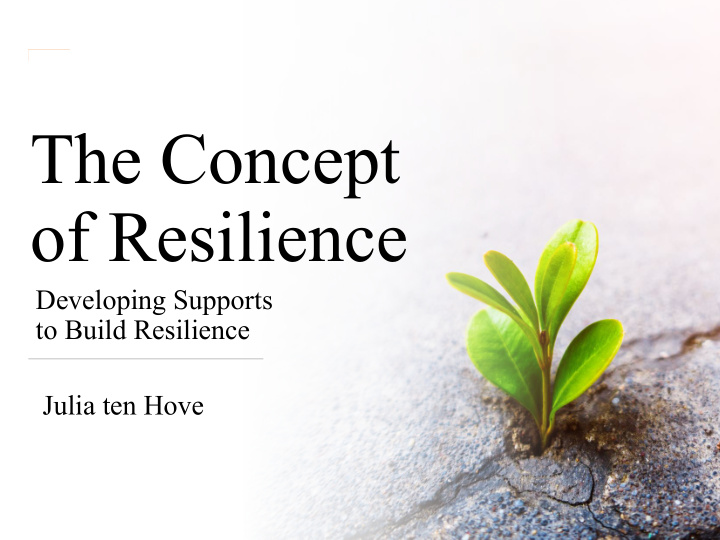



The Concept of Resilience Developing Supports to Build Resilience Julia ten Hove
What is Resilience? A network of resources, patterns of adaptation and supportive relationships… • A dynamic concept or state that is promoted and enhanced through a host of environmental factors • Developing environmental supports in a child’s life is the best way to set them up for future success
Concepts of Resilience
Sense of Coherence • A feeling of confidence that one’s environment is predictable and that things will work out in away that is reasonably expected • Built from three main elements: 1. Comprehensibility 2. Manageability 3. Meaningfulness*
Meaning-Making 1. Belonging to 2. Through activity 3. Gaining a greater something bigger and participation understanding of (such as ourselves and our community) world
Ways of thinking about Resilience…
International Classification of Functioning, Disability & Health (ICF) Framework
Integrating Resilience in the ICF • Dynamic framework offers a foundation on which we can conceptualize the complex idea of ‘resilience’ for clinical application • Discussing resilience within a well-established framework provides opportunity for people to remember these concepts, and then apply and promote them
The 4P Framework of Factors Predisposing Factors Put individual at risk of developing the problem, or risk of an adversity presenting itself Precipitating Factors Specific events or triggers that lead to the onset of the problem Perpetuating Factors Factors that act to maintain the problem once it is established Protective Factors Represent the strengths of an individual and of their environment
Measuring Resilience Connor-Davidson Resilience Scale (CD-RISC) • 25-, 10- and 2-item survey rated on a 5-point scale • Recognizes environment as one of the biggest variables in outcome measures of resilience Child Youth and Resilience Measure (CYRM) • A measure of the resources available to an individual that may help them adapt from an adverse situation and boost resilience Qualitative Assessment • Using the ICF to frame and analyze resilience factors in a clinical setting
Resilience in Practice A CASE REPORT
8-year old boy with Developmental John Coordination Disorder (DCD) At School: His teacher notes he is sullen, withdrawn, and involved in some aggressive interactions with classmates John is sometimes teased by other children because of his ‘clumsiness’ His teacher wants John to become more resilient and cope more effectively with issues, so she calls a meeting with John’s parents…
John At Home: John’s mother is surprised by his behavior. He plays well at home with his siblings and is helpful around the house, despite his need for extra time for some of his activities of daily living. John’s father is frustrated with John, who is not good at physical activities like catching and throwing a ball – a source of tension between the parents
How might the concepts of resilience be applied to help John?
Using an ICF-Based Approach
Using a 4Ps-Based Approach 1. Predisposing factors? 2. Precipitating factors? 3. Perpetuating factors? • Isolation from classmates • Confused or upset with father’s frustration 4. Protective factors… Consider interventions that may address the predisposing, precipitating, and perpetuating factors, and build on and promote protective ones?
Discussion Questions Can a child gain/lose the ability to demonstrate resilience? Is resilience a fixed trait? What is the best way to measure resilience?
Recommend
More recommend